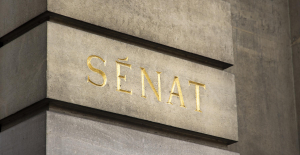Cataract surgery is the most frequently performed operation in France with nearly 1 million interventions in 2022. This age-related pathology results from the opacification of the lens following the formation of clusters of particles at the inside the organ. The lens is a transparent natural lens behind the iris, which allows light rays to converge inside the eye to focus on the retina. Opacification blocks this transmission and ultimately threatens blindness.
Around 5% of individuals are affected over the age of 65, and more than a quarter after the age of 80. Simply annoying at first in the form of a feeling of “dirty glasses”, halos and glare, cataracts gradually become very disabling. The progressive loss of vision limits daily activities with difficulty reading, watching television, driving, etc. Surgery is then the only therapeutic option and can be carried out at any age, including very advanced ones. Currently the average is 72-73.
The operation takes place on an outpatient basis and usually lasts fifteen to thirty minutes. It involves removing the lens to place an artificial lens, also called an “intraocular implant”. The operation takes place under local anesthesia obtained by instilling drops or gel into the eye and it is held open by an eyelid retractor.
The surgeon makes a small 2.2 millimeter incision, then inserts an ultrasound probe into the lens sac to break up the contents and suction them out. He then places the implant which will have been carefully chosen according to the patient. Indeed, this operation not only treats cataracts, but also corrects vision in general, presbyopia, myopia, hyperopia or even astigmatism.
“Cataract surgery, which compensates for vision defects, makes it possible in many cases to remove glasses postoperatively. We are talking about refractive surgery,” explains Professor Béatrice Cochener, ophthalmic surgeon at Brest University Hospital and president of the National Professional Council of Ophthalmology.
“Monofocal” implants correct distance or near vision. “Multifocals” divide the light into several foci for focusing at different distances. Implants, called “Edof” for extended depth of field, improve distance and intermediate vision, avoiding the formation of halos and a reduction in contrast which sometimes result from multifocal corrections. All of these products can also be “toric” to additionally correct astigmatism… “There have been significant technical advances, now offering many possibilities depending on each individual situation,” summarizes Béatrice Cochener.
After surgery, vision generally improves the next day. The operation goes well in the vast majority of cases, however the risk of complications is not zero; rupture of the lens sac, infection, edema… “These events are extremely rare,” recalls Dr. Barbara Ameline, ophthalmic surgeon in Paris and vice-president of the French Ophthalmological Society. And we achieve the expected result in visual correction in more than 90% of cases.” However, this operation raises some concern among a large number of patients because the eyes are a precious organ. The initial consultation is generally much longer than the operation itself to reassure them!

 Gaza: under the spotlight, the Israeli-Palestinian conflict shakes up the Eurovision contest
Gaza: under the spotlight, the Israeli-Palestinian conflict shakes up the Eurovision contest Black soldier killed by a police officer in the United States: the sheriff publishes the video of the arrest
Black soldier killed by a police officer in the United States: the sheriff publishes the video of the arrest In Malmö, the Eurovision party transformed into entrenched camps
In Malmö, the Eurovision party transformed into entrenched camps In Russia, Vladimir Putin stigmatizes “Western elites”
In Russia, Vladimir Putin stigmatizes “Western elites” “Mediterranean diet” or “DASH”, two good tips for eating better
“Mediterranean diet” or “DASH”, two good tips for eating better Fatal case of cholera in Mayotte: the epidemic is “contained”, assures the government
Fatal case of cholera in Mayotte: the epidemic is “contained”, assures the government The presence of blood in the urine, a warning sign of bladder cancer
The presence of blood in the urine, a warning sign of bladder cancer A baby whose mother smoked during pregnancy will age more quickly
A baby whose mother smoked during pregnancy will age more quickly Artificial intelligence lies, cheats and deceives us, and that's a problem, experts warn
Artificial intelligence lies, cheats and deceives us, and that's a problem, experts warn Google Cloud mistakenly deletes UniSuper fund account and deprives 600,000 Australians of their superannuation
Google Cloud mistakenly deletes UniSuper fund account and deprives 600,000 Australians of their superannuation IBM, Amazon, Hager... These record investments expected at the Choose France summit
IBM, Amazon, Hager... These record investments expected at the Choose France summit Boeing's black streak: a second Air France flight diverted in three days for “a smell of heat”
Boeing's black streak: a second Air France flight diverted in three days for “a smell of heat” Paola Locatelli: “Influence is comfortable but cinema gives me adrenaline”
Paola Locatelli: “Influence is comfortable but cinema gives me adrenaline” Swifties attack hotels in Lyon
Swifties attack hotels in Lyon Radical Optimism by Dua Lipa, a tangy album in half-tone
Radical Optimism by Dua Lipa, a tangy album in half-tone Peter Weir rewarded for his career with an honorary Golden Lion at the Venice Film Festival in September
Peter Weir rewarded for his career with an honorary Golden Lion at the Venice Film Festival in September Omoda 7, another Chinese car that could be manufactured in Spain
Omoda 7, another Chinese car that could be manufactured in Spain BYD chooses CA Auto Bank as financial partner in Spain
BYD chooses CA Auto Bank as financial partner in Spain Tesla and Baidu sign key agreement to boost development of autonomous driving
Tesla and Baidu sign key agreement to boost development of autonomous driving Skoda Kodiaq 2024: a 'beast' plug-in hybrid SUV
Skoda Kodiaq 2024: a 'beast' plug-in hybrid SUV The home mortgage firm rises 3.8% in February and the average interest moderates to 3.33%
The home mortgage firm rises 3.8% in February and the average interest moderates to 3.33% This is how housing prices have changed in Spain in the last decade
This is how housing prices have changed in Spain in the last decade The home mortgage firm drops 10% in January and interest soars to 3.46%
The home mortgage firm drops 10% in January and interest soars to 3.46% The jewel of the Rocío de Nagüeles urbanization: a dream villa in Marbella
The jewel of the Rocío de Nagüeles urbanization: a dream villa in Marbella Diving into the secrets of the National Assembly
Diving into the secrets of the National Assembly Institutions: senators want to restore the accumulation of mandates and put an end to the automatic presence of ex-presidents on the Constitutional Council
Institutions: senators want to restore the accumulation of mandates and put an end to the automatic presence of ex-presidents on the Constitutional Council Europeans: David Lisnard expresses his “essential and vital” support for François-Xavier Bellamy
Europeans: David Lisnard expresses his “essential and vital” support for François-Xavier Bellamy Facing Jordan Bardella, the popularity match turns to Gabriel Attal’s advantage
Facing Jordan Bardella, the popularity match turns to Gabriel Attal’s advantage These French cities that will boycott the World Cup in Qatar
These French cities that will boycott the World Cup in Qatar NBA: Boston and Dallas rely on their star duos to win
NBA: Boston and Dallas rely on their star duos to win Athletics: Samba-Mayela improves her own French record in 100m hurdles
Athletics: Samba-Mayela improves her own French record in 100m hurdles “We’re not going to catch fire,” tempers Louis Bielle-Biarrey (Bordeaux-Bègles)
“We’re not going to catch fire,” tempers Louis Bielle-Biarrey (Bordeaux-Bègles) Ligue 1: suspense on all levels
Ligue 1: suspense on all levels


















